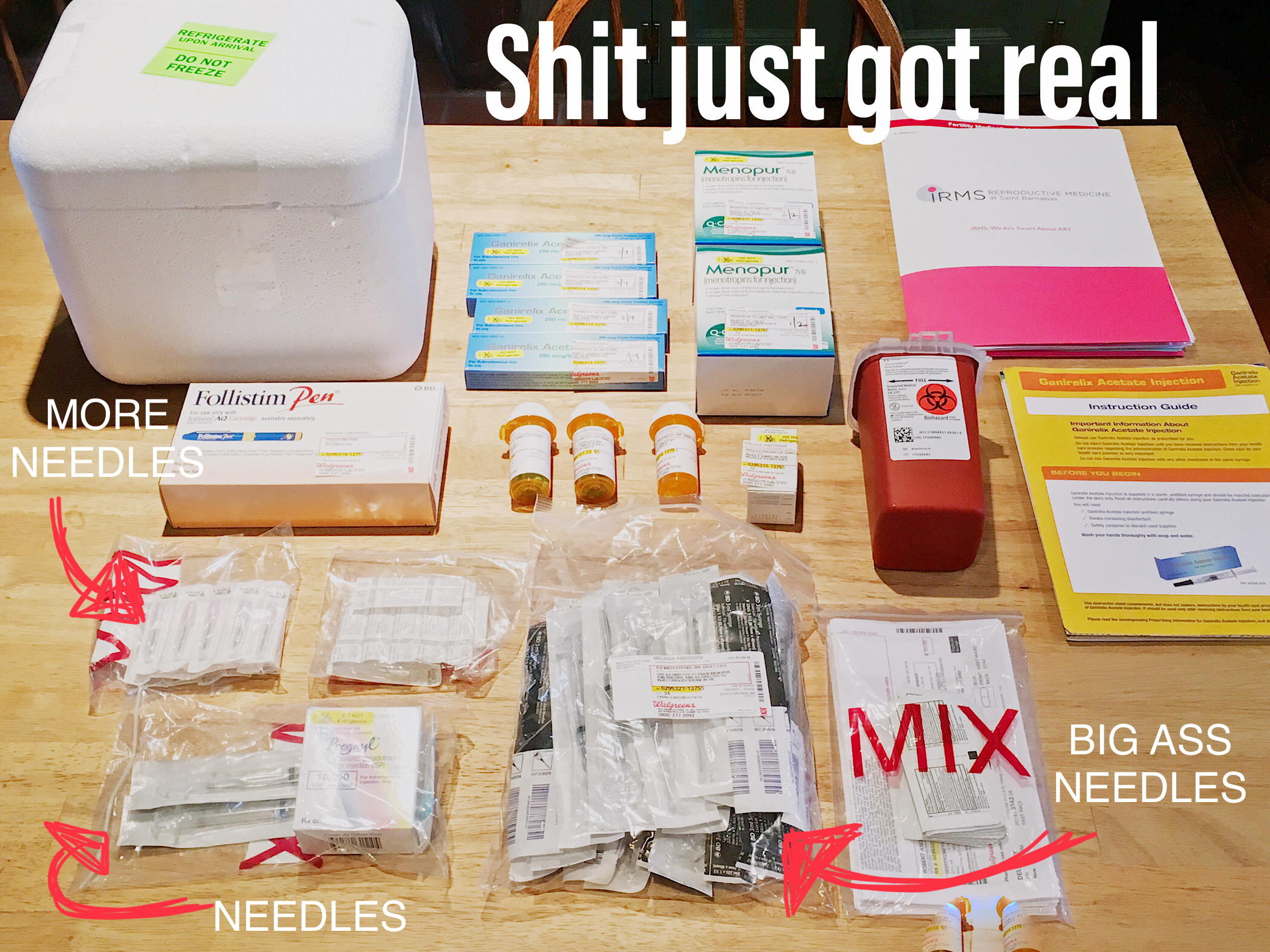The Price of Infertility
Much of this blog is (and will continue to be) dedicated to the emotional, mental, and physical effects of infertility. But no discussion of infertility is complete without an examination of a much more tangible effect - one that often precludes a couple’s fertility journey: the financial one. There’s a devastating lack of insurance coverage for fertility treatments in this country, and even when insurance does kick in, it rarely covers everything. For far too many couples, this immense financial burden is so devastating that it stops their dreams of having a baby right in their tracks. For those couples, treatments like IVF are not even an option; if it doesn’t happen naturally, it doesn’t happen at all. And for those who can scrape enough money together to afford just one cycle, they often feel pressured to make risky decisions to boost their odds of conception.
When we first started looking into IVF many months ago, we found plenty of answers to our questions about the procedure itself, and some information about the testing leading up to it. What we were missing (and especially as the Type As we both are) was a step-by-step breakdown of what IVF entails and what it costs. We saw plenty of numbers being thrown around, but those numbers differed wildly, from the low thousands to $30,000 or more.
With the stress of our diagnosis, the treatments ahead, and, oh yeah, the fact that there is still no guarantee we will have a baby at the end of it all, we now faced another giant question mark: the massive blow to our bank account. I’m self-employed and while Bobby has a traditional nine-to-five that provides insurance coverage, like many small businesses in this country, his company’s insurance plan options offer no fertility coverage. None. And it’s not like we went for the skimpy insurance plan. I’m a living kidney donor, so we always make sure to get the best insurance plan offered through his job. We’ve been told that some of our diagnostic testing will be covered (i.e. the first - and only the first - visit to the urologist, blood work, and the like - essentially anything that happened before the infertility diagnosis), but the actual IVF procedures, medications, etc. are all out of pocket. (Note: We’ve already seen pushback from our insurance company on the diagnostic testing, so even that coverage is up in the air at this point).
Insurance companies robbing the infertile
While many states have mandates that a certain percentage of fertility treatments have to be covered, and some companies opt to offer it of their own accord, there are countless people in the same boat as us (I’ll save my rant about how we’re one of the only developed countries that doesn’t offer fertility coverage for another post). IVF and infertility are already full of what-ifs, and price shouldn’t be one of them. So we decided that in the name of transparency, we’re going to do a series of updates on where we currently are in the process, how much each step is costing us, and the total we’ve paid out of pocket (or are committed to pay) so far (hell, we’ve already talked in depth about Bobby’s sperm and my transvaginal ultrasounds, so why get sheepish now?). While every couple has a different experience with cost (and there are many factors that affect prices), we hope that we can offer a bit of insight for those who are facing this long road with us.
Here’s what we’ve done so far:
Urology: Bobby had three semen analyses done before we received the official diagnosis of infertility. Bobby is in the midst of pushing his insurance company to cover all of these visits under “diagnostic coverage.” Cost: TBD/pending insurance coverage
Natural supplements: While Bobby was undergoing treatment for his morphology issues, he decided to go bonkers and buy every single supplement he found associated with fertility (like I said, we’re Type As). Conservative estimate of additional supplements: $600 (some are ongoing)
First fertility specialist visit: When it came time to see a specialist, we did a lot of research and decided to go with IRMS (The Institute for Reproductive Medicine and Science at Saint Barnabas) in Livingston, NJ, which we’d heard and read a lot of good things about. (BONUS: If I do get pregnant, Saint Barnabas has an incredible NICU). During this first visit we met with our doctor, discussed options, gave blood for health screenings and genetic testing, and met with the financial coordinator. I also had a pap smear and a transvaginal ultrasound done to see how my ovaries looked and how many follicles I have (good marks on both counts). Co-pay: $30
Day 3 blood draw: On the third day of my next menstrual cycle, I had to report back to the clinic to have my blood taken for baseline hormone testing. This gives the doctor a picture of my hormone levels so she can tell if my reproductive system is functioning properly. Luckily, everything came back perfect. Cost: TBD/pending insurance coverage
Saline sonogram: Between days 5 and 10 of your menstrual cycle, patients have a saline sonogram performed. I went on day 6. I was a little nervous about this procedure because I had read that many people found it painful. Essentially, this is a vaginal ultrasound where a saline solution is injected into the uterus so the doctor can get a clear picture of your uterus and evaluate its health, as well as identify any growths or abnormalities. I did experience some discomfort during the procedure, but it was very quick (a few minutes) and I had only mild cramping afterwards. My uterus checked out a-ok. Cost: TBD/pending insurance coverage
Carrier testing: As I mentioned in my last blog post, Bobby and I are opting to do everything we can to achieve the best possible outcome (a healthy baby) in one round of IVF. In addition to having our embryos genetically tested (that comes later), we also had our own blood tested to see if either of us are carriers. According to Counsyl (the organization that conducted our DNA tests through our fertility clinic), “Carrier testing is a way to see whether we carry certain mutations in our DNA that may not affect us, but can cause our children to inherit a disease. If both parents are carriers of the same mutation, their child has a significant chance of suffering from a serious genetic disease, like cystic fibrosis, spinal muscular atrophy (SMA), fragile X, sickle cell disease, or Tay-Sachs disease.” Fortunately, both of our tests came back negative. Estimated out-of-pocket cost: $67.32 x 2 tests = $134.64 (pending insurance coverage)
Here’s where we are RIGHT NOW:
Round 1 medications: For us, this was the first major cost of the process. According to our clinic, most couples can expect their medications for one cycle to be between $5,000 and $8,000. However, because I don’t have any fertility issues myself or any underlying health concerns, our clinic estimated our cost to be on the lower end - somewhere between $4,000 and $5,000. Since we’re paying out of pocket, our clinic was careful to order slightly less medication than I will likely need in my first round so that there is no risk of overbuying and paying for medication I won’t end up using. We ordered through a specialty pharmacy that offers discounts for out-of-pocket patients. Below is a list of all the meds and prices for the first round (I will most likely have to order more of certain medications before the cycle is complete, depending on how my body responds and other factors. Therefore, our total round 1 meds cost could increase):
Out of pocket meds:
- Follistim: 2 units at $862.80 each: $1,725.60
- Menopur: 10 units at $82.99 each: $829.90
- Ganirelix: 4 units at $139.95 each: $559.80
- Pregnyl: 1 unit at $101.09 each: $101.09
Covered by insurance (with copay):
- Medrol (prednisone): $10
- Doxycycline (antibiotics for Bobby): $10
- Doxycycline (antibiotics for me): $8.64
- Progesterone in oil: $10
Total for cycle 1 medications so far (including pharmacy discounts): $3,055.03
IVF with ICSI (Intracytoplasmic sperm injection) and Embryo Freezing: This is the big whopper of IVF costs. It covers everything performed by our clinic while in-cycle, including monitoring (the blood draws and ultrasounds I will be getting almost daily), procedure/embryology (egg retrieval, sperm prep, ICSI, culture, assisted hatching, and more), embryo biopsies for genetic testing (PGD), embryo cryopreservation, and up to one year of embryo storage. Normally this would cost $17,175, but the clinic provides a discount for out-of-pocket patients. Cost due in full prior to cycle initiation: $14,000
Anesthesia/facility fees: The retrieval process is performed by my IRMS doctor, but the procedure requires anesthesia and the use of St. Barnabas facilities. Cost: $1,600
Preimplantation Genetic Screening (PGS): While our clinic, IRMS, does the biopsy of our embryos, the actual testing is done off-site through a reprogenetics lab. We won’t know final costs until we know how many fertilized embryos we end up with (if any). Cost: $850 base fee + $250 per embryo







